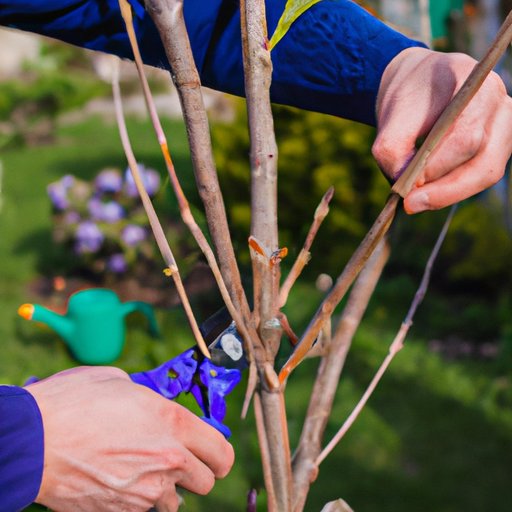Introduction
Lilac bushes (Syringa) are a genus of flowering shrubs that belong to the olive family. These lovely plants produce fragrant clusters of colorful flowers in shades of purple, blue, pink and white. They are very easy to grow and can provide years of beauty to any landscape. In addition to their aesthetic appeal, they also attract birds, bees and butterflies to your garden.
Planting Lilac Bushes: A Step-By-Step Guide
When planting your lilac bush, there are several important steps to follow to ensure its success. Here is a quick overview of what you need to do:
Location
The first step is to pick the perfect spot for your lilac bush. It should be in an area that receives full sun for at least six hours per day. Avoid areas near trees or other large plants that may block the light.
Soil Preparation
The next step is to prepare the soil. Lilac bushes prefer well-drained, slightly acidic soil. If necessary, add compost or peat moss to improve drainage and acidity. Make sure to loosen the soil before planting.
Planting
Once the soil is ready, it’s time to plant your lilac bush. Dig a hole that is twice as wide as the root ball and just deep enough to accommodate the roots. Place the bush in the hole and fill it in with soil. Water thoroughly after planting.
Care & Maintenance
Lilac bushes require minimal care. Water regularly during dry periods, but avoid over-watering. Fertilize lightly once or twice a year. Prune in late winter or early spring to maintain shape and size.

Growing Lilac Bushes From Cuttings
If you don’t have access to a mature lilac bush, you can propagate one from cuttings. Here’s what you need to do:
Cutting Preparation
Choose healthy branches from an existing bush and snip them off with sharp pruning shears. The cuttings should be 4-6 inches long. Remove any leaves and flowers, then dip the cut end in rooting hormone.
Planting the Cuttings
Fill a pot with damp potting soil and make a hole for each cutting. Insert the cuttings into the holes, making sure the dipped end is facing down. Cover the pot with plastic wrap and place in a warm, sunny spot.
Care & Maintenance
Keep the soil moist but not soggy. Once the cuttings have taken root, remove the plastic wrap and move the pot outdoors. Water and fertilize regularly and transplant to a larger pot or the ground when the plants are established.

How to Prune and Care for Your Lilac Bushes
Proper pruning and care will help keep your lilac bush looking its best. Here are some tips to remember:
Pruning Basics
Pruning should be done in late winter or early spring before new growth begins. Remove dead or damaged branches and trim back any overly long branches. Avoid pruning more than 1/3 of the bush at once.
Proper Pruning Techniques
When pruning, always use sharp pruning shears and make clean cuts. Make sure to sterilize the shears between cuts to prevent spreading disease. Also, prune away any branches that cross or rub against each other.
Disease and Pest Control
Lilac bushes are susceptible to several diseases and pests. To prevent infestations, keep the area around the bush free of debris and weeds. Prune away any diseased or damaged branches and treat with an appropriate fungicide or pesticide.
Tips on Selecting the Perfect Variety of Lilac Bush
When choosing a lilac bush, there are several factors to consider. Here are some tips to help you find the perfect variety:
Height & Width
Lilac bushes range in height and width from dwarf varieties to tall and sprawling bushes. Consider the space you have available before making a selection.
Flower Color & Fragrance
Lilac bushes come in a variety of colors and fragrances. Choose a color and scent that appeals to you.
Hardiness & Sun Requirements
Different varieties of lilacs have different hardiness zones and sun requirements. Make sure to select a variety that is suitable for your climate and growing conditions.

Turning Your Garden Into a Fragrant Wonderland with Lilac Bushes
Adding a few lilac bushes to your garden can turn it into a fragrant wonderland. Here are some tips to help you create a beautiful display:
Combining Varieties
Mix and match different varieties of lilac bushes to create a unique display. Try combining colors, heights and fragrances to create a beautiful and inviting garden.
Planting Patterns
When planting your lilac bushes, experiment with different patterns and layouts. Consider clustering several bushes together or arranging them in a line to create a visual impact.
Mulching & Fertilizing
To keep your lilac bushes healthy and happy, add a layer of mulch around the base of the plant. This will help retain moisture and discourage weeds. Fertilize lightly in the spring and fall with a balanced fertilizer.
Conclusion
Lilac bushes are a wonderful addition to any garden. With their delicate blooms and sweet fragrance, they will bring beauty and enchantment to your outdoor space. By following these simple steps, you can easily learn how to start lilac bushes and turn your garden into a fragrant oasis.
(Note: Is this article not meeting your expectations? Do you have knowledge or insights to share? Unlock new opportunities and expand your reach by joining our authors team. Click Registration to join us and share your expertise with our readers.)
